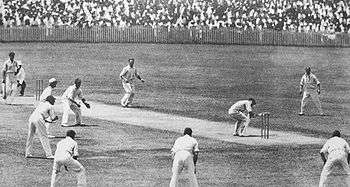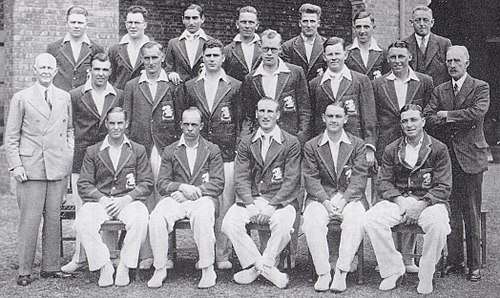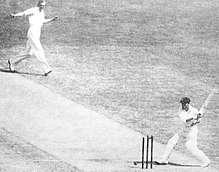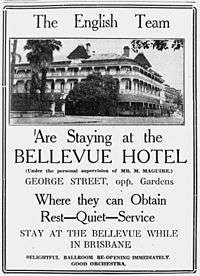English cricket team in Australia in 1932–33
A cricket team representing England toured Australia in the 1932–33 season. The tour was organised by the Marylebone Cricket Club and matches outside the Tests were played under the MCC name. The tour included five Test matches in Australia, and England won The Ashes by four games to one. The tour was highly controversial because of the bodyline bowling tactics used by the England team under the captaincy of Douglas Jardine. After the Australian tour was over, the MCC team moved on to play in New Zealand, where two further Test matches were played.
| 1932–33 Ashes series | |||||||||||||||||||||||||
|---|---|---|---|---|---|---|---|---|---|---|---|---|---|---|---|---|---|---|---|---|---|---|---|---|---|
 Bill Woodfull evades a bodyline ball | |||||||||||||||||||||||||
| Date | 2 December 1932 – 28 February 1933 | ||||||||||||||||||||||||
| Location | |||||||||||||||||||||||||
| Result | England won the 5-test series 4-1 | ||||||||||||||||||||||||
| |||||||||||||||||||||||||
The MCC team

Back row: George Duckworth, Tommy Mitchell, Nawab of Pataudi, Maurice Leyland, Harold Larwood, Eddie Paynter, W. Ferguson (scorer)
Middle row: Pelham Warner (co-manager), Les Ames, Hedley Verity, Bill Voce, Bill Bowes, Freddie Brown, Maurice Tate, R. C. N. Palairet (co-manager).
Front row: Herbert Sutcliffe, Bob Wyatt, Douglas Jardine, Gubby Allen, Wally Hammond
The MCC team was captained by Douglas Jardine, with Bob Wyatt as vice-captain. Pelham Warner and Richard Palairet were joint managers.
The team members were:
- Douglas Jardine, Surrey, team captain & batsman
- Bob Wyatt, Warwickshire, vice-captain & batsman
- Gubby Allen, Middlesex, all-rounder
- Les Ames, Kent, wicket-keeper
- Bill Bowes, Yorkshire, fast bowler
- Freddie Brown, Surrey, leg break bowler
- George Duckworth, Lancashire, wicket-keeper
- Wally Hammond, Gloucestershire, all-rounder
- Harold Larwood, Nottinghamshire, opening fast bowler
- Maurice Leyland, Yorkshire, batsman
- Tommy Mitchell, Derbyshire, leg break bowler
- Nawab of Pataudi, Worcestershire, batsman
- Eddie Paynter, Lancashire, batsman
- Herbert Sutcliffe, Yorkshire, opening batsman
- Maurice Tate, Sussex, all-rounder
- Hedley Verity, Yorkshire, left arm spin bowler
- Bill Voce, Nottinghamshire, opening fast bowler
Walter Robins and Kumar Shri Duleepsinhji were invited to tour, but declined to do so, the latter because of ill-health.[1]
Test matches
First Test
v |
||
- Australia won the toss and elected to bat.
- Test debuts: Lisle Nagel (Australia) and the Nawab of Pataudi (England)
An easy victory for England, with Bradman absent for Australia. McCabe provided Australia's only significant resistance with the bat; Larwood claimed ten match wickets. Pataudi's century on Test debut was to be his sole Test century, and he was dropped after the second Test due to his dissent against Bodyline tactics (when he refused to move to a leg-side fielding position, Jardine is said to have commented "I see his highness is a conscientious objector").
Second Test

On his return, Bradman was bowled first ball in the first innings when expecting a bouncer; Fingleton was left to hold Australia's first innings together. Nonetheless, an unbeaten century for Bradman in the second innings, and ten wickets for O'Reilly, granted Australia their only victory of the Test series.
Third Test
v |
||
- England won the toss and elected to bat.
- Bert Oldfield (Australia) retired hurt during Australia's 1st innings after suffering a fractured skull.
The match best known for Bodyline, with Woodfull receiving a blow to the chest (although he stayed at the crease to make an obdurate 73 not out) and Oldfield a fractured skull from Larwood's hostile fast bowling. Larwood took seven wickets in the match, but the principal wicket-taker was Allen, who took four in either innings despite his notable dissent against Bodyline.
Fourth Test
v |
||
- Australia won the toss and elected to bat.
- Test debuts: Len Darling, Ernest Bromley, Hammy Love (Australia), and Thomas Mitchell (England)
A match best remembered for the heroism of Paynter, who despite spending much of the match in hospital with severe tonsillitis, scored 83 in the first innings, and won the match with a six in the second.

Fifth Test
v |
||
- Australia won the toss and elected to bat.
Fine performances from both sides' middle orders (with some aid from dropped catches) led to approximate parity after the first innings. Hammond (101) and Larwood (98) in particular batted excellently; Larwood, promoted to number four as a night-watchman, scored the then highest innings ever made in that role. Bradman and Woodfull shared a partnership of 115 in Australia's second innings before Verity induced a collapse, and Wyatt and Hammond experienced little difficulty in reaching a target of 164, with Hammond in particularly belligerent form.
Ceylon
The English team had a stopover in Colombo en route to Australia and played a one-day single-innings match there against the Ceylon national team, which at that time did not have Test status.[2]
See also
For details of the tactics involved in Bodyline bowling, see the Bodyline article.
References
- "The M.C.C. Team in Australasia". Wisden Cricketers' Almanack (1934 ed.). Wisden. pp. 629–673.
- "Ceylon v MCC 1932". CricketArchive. Retrieved 3 July 2014.
Further reading
- Bill Frindall, The Wisden Book of Test Cricket 1877-1978, Wisden, 1979
- Chris Harte, A History of Australian Cricket, Andre Deutsch, 1993
- Ray Robinson, On Top Down Under, Cassell, 1975
- Wisden Cricketers' Almanack, 1934 edition, carries tour and match reports in a section entitled "M.C.C. Team in Australasia" on pages 629 to 673.
| Wikimedia Commons has media related to The Ashes, 1932-33. |